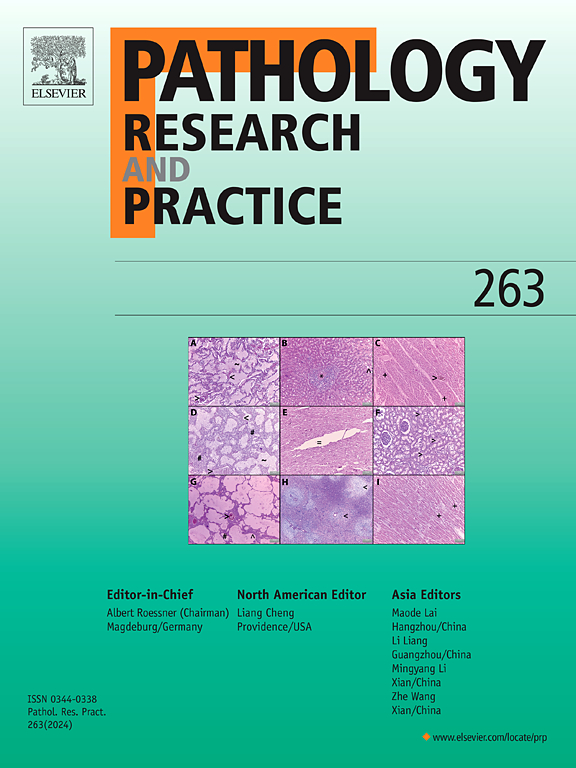坏死性小肠结肠炎的表型与肠道连接蛋白的明显变化有关。
IF 2.9
4区 医学
Q2 PATHOLOGY
引用次数: 0
摘要
坏死性小肠结肠炎(NEC)是早产儿死亡的主要原因。人们对其病理生理学仍知之甚少,但肠道上皮屏障功能障碍是导致该病的原因之一。我们对早产儿肠道标本中的连接蛋白进行了鉴定。我们从 27 名 NEC 患者和 20 名局灶性肠穿孔(FIP)患者的标本中心(受影响)或宏观健康的切除边缘(非受影响)采集了样本。与 FIP 患者相比,NEC 患者的死亡率较高,且更常出现糖稳态受损、动脉导管未闭、贫血和抗生素治疗。根据使用新开发的评分系统进行的H.E.染色,无法在受影响区域区分NEC和FIP。免疫荧光显示,受影响的NEC样本中Claudin-3减少,而受影响的FIP和所有NEC样本中Claudin-4减少。E-cadherin和Desmoglein-2在受影响的NEC样本中减少。在受 FIP 影响的肠道和 NEC 患者未受影响的肠道中,Plakophilin-2 减少。在 NEC 受影响的区域,Plakophilin-2 完全消失。受影响的 NEC 样本中 Plakoglobin 的减少与存活率低有关。这项研究为了解 NEC 中连接蛋白的变化提供了新的视角,建议将 Claudin-3 和 Plakophilin-2 作为诊断标志物来区分 FIP 和 NEC,并将 Plakoglobin 的减少作为预后标志物。本文章由计算机程序翻译,如有差异,请以英文原文为准。
The phenotype of necrotizing enterocolitis correlates with distinct changes of intestinal junctional proteins
Necrotizing enterocolitis (NEC) is a major cause of mortality in preterm infants. Its pathophysiology remains poorly understood but intestinal epithelial barrier dysfunction contributes to the disease. We characterized junctional proteins in intestinal specimens from preterm infants. Samples from 27 patients with NEC and 20 patients with focal intestinal perforation (FIP) from the center of the specimens (affected) or the macroscopically healthy resection margins whenever available (non-affected) were collected. NEC patients displayed higher mortality and more commonly occurrence of impaired glucose homeostasis, patent ductus arteriosus, anemia and antibiotic treatment compared to FIP patients. Discrimination between NEC and FIP was not possible in affected areas based on H.E. staining using a newly developed scoring system. Immunofluorescence revealed reduced Claudin-3 in affected NEC samples and decreased Claudin-4 in affected FIP and all NEC samples. E-cadherin and Desmoglein-2 were reduced in a subgroup of the affected NEC samples. Plakophilin-2 was decreased in intestine affected by FIP and unaffected intestine in patients with NEC. In affected areas of NEC, Plakophilin-2 was completely lost. Plakoglobin reduction in affected NEC samples correlated with poor survival. This study provides novel insights into changes of junctional proteins in NEC, suggesting Claudin-3 and Plakophilin-2 as diagnostic markers to differentiate FIP from NEC and reduced Plakoglobin as a prognostic marker.
求助全文
通过发布文献求助,成功后即可免费获取论文全文。
去求助
来源期刊
CiteScore
5.00
自引率
3.60%
发文量
405
审稿时长
24 days
期刊介绍:
Pathology, Research and Practice provides accessible coverage of the most recent developments across the entire field of pathology: Reviews focus on recent progress in pathology, while Comments look at interesting current problems and at hypotheses for future developments in pathology. Original Papers present novel findings on all aspects of general, anatomic and molecular pathology. Rapid Communications inform readers on preliminary findings that may be relevant for further studies and need to be communicated quickly. Teaching Cases look at new aspects or special diagnostic problems of diseases and at case reports relevant for the pathologist''s practice.

 求助内容:
求助内容: 应助结果提醒方式:
应助结果提醒方式:


